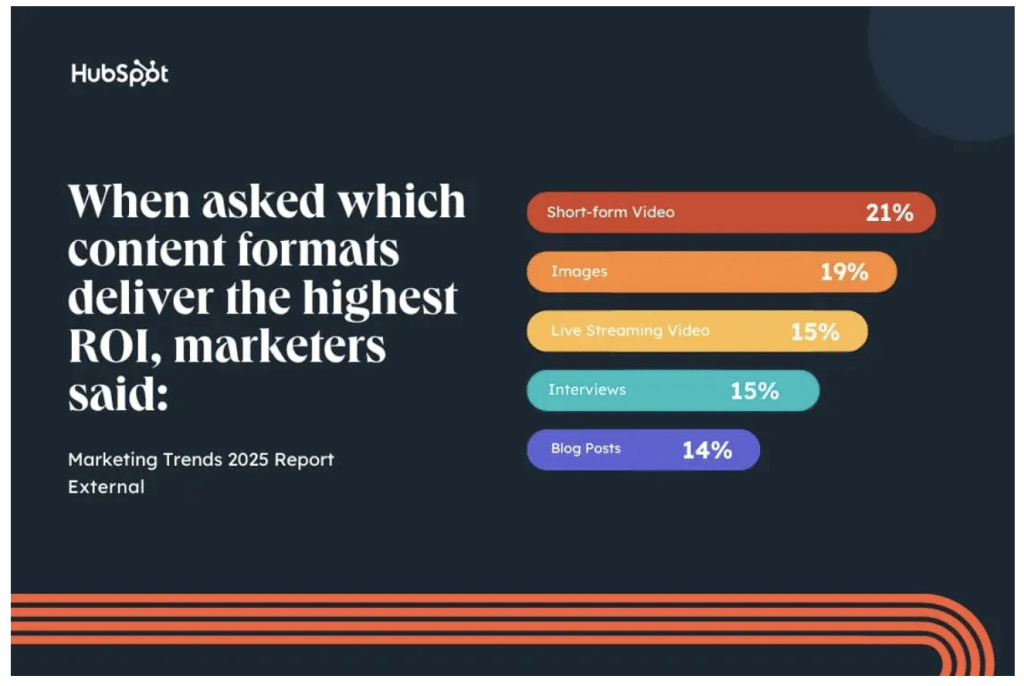The digital marketing landscape is always evolving, but in 2025, the pace of change appears to be accelerating faster than ever, thanks to rapid technological advances and shifting consumer behaviors.
From the rise of artificial intelligence (AI)-powered tools to the dominance of short-form video and the increasing reliance on first-party data, advertisers must continually adapt if they want to stay ahead. In this article, I’ll examine the key digital marketing trends shaping the industry today and provide insights on how to focus your efforts to maximize results.
18 Insightful Digital Marketing Trends Advertisers Should Know of in 2025
1. Social Media Short-Form Video Content
Social media platforms remain critical to digital advertisers, but it’s important to note that the way users engage with social media is shifting. According to Hubspot, marketers say that short-form video delivers the highest return on investment (ROI), which means that advertisers need to adapt their strategies. Major trends include a shift toward short-form video on platforms like TikTok, Instagram Reels, and YouTube Shorts — even Threads is emerging as a promising platform for short-form content.
- According to Sprout Social’s Benchmark report, almost 80% of people prefer to learn about new products through short-form video content.
- 93% of marketers say they will invest more time in social media marketing in 2025, per the same report.
2. Combat Rising CPM Costs with Channel Diversification
As advertisers continue to shift towards social media advertising, increasing CPMs and diminishing returns on popular platforms like TikTok, Meta, and YouTube are requiring them to increase their social ad spend. To lower costs, consider diversifying via efforts on the open web, where a mix of native and display ads, alongside content recommendations, can drive strong performance. Channel diversification also prevents advertisers from becoming dependent on closed platforms that can change dramatically with little notice, e.g., Twitter/X and Meta making changes to their content moderation policies.
- TikTok’s Q1 2025 U.S. ad spend rose by 15.6%, according to EMarketer.
- CPMs (cost per mille, i.e., the price an advertiser pays for each 1,000 impressions of an ad) continue to rise across several popular platforms, per the same report.
3. AI and Emerging Technologies
In 2025, brands are using AI more than ever to create, test, deliver, and optimize their ad campaigns. Take content creation, for example: AI tools now allow you to generate multiple headlines and ad copy variations tailored for different campaign goals, audience segments, and platforms. This speeds up the creative process for advertisers, allowing them to experiment more quickly than in the past — and free up their time for more strategic work. Major ad networks, such as Google, Meta, and Realize, are also now utilizing AI-powered bidding strategies that analyze user behavior, enabling them to adjust bids in real time, helping to optimize spend.
Discover What Your Audience is Interested In
Some brands are also experimenting with features like AI-generated voices, synthetic media (sometimes referred to as “deepfake” tech when used for more nefarious purposes) for virtual influencers, and lifelike AI avatars, making digital content far more interactive. Ultimately, all of this will continue to change the way marketers work.
- According to Hubspot, 92% of marketers say AI has already impacted their role.
- Despite this, the same report found that only 47% of marketers clearly understand how to use AI in their marketing strategy.
4. Search
In the past, marketers relied on finding high-volume, low-competition keywords that matched what people were typing into search engines. In Google Ads or other pay-per-click (PPC) platforms, this meant bidding on specific keywords. Theoretically, the better the keyword targeting, the more likely a campaign would convert.
However, this method is less effective in 2025, as Google’s AI Overviews and Microsoft Copilot often provide direct answers instead of webpage links. This means that marketers need to consider AEO (answer engine optimization) as well as traditional SEO, and ensure their content clearly answers questions and covers topics in depth. They also need to optimize for new formats, such as voice and visual search.
5. Content
Perhaps the most significant trend in content for 2025 is that AI-powered content has become the new norm. AI tools such as ChatGPT, Jasper, Synthesia, and Descript are transforming how written and video content is created and edited, and how quickly. Additionally, the combination of first-party data and AI is allowing advertisers to create highly personalized content based on real-time behavior, instead of relying simply on audience demographics.
Realize leverages Taboola's extensive first-party data from powering publisher editorial and ad units, providing unmatched insights and targeting capabilities.
6. Video
Video remains a critical medium for advertisers in 2025, but other, highly interactive mediums, such as quizzes and polls, augmented and virtual reality (AR/VR), and audio (podcasts and voice content) are also performing very well. Regarding audio, consider this: There are more than 584 million podcast listeners worldwide, and the number is growing.

(Source: Hubspot Blog)
But, that doesn’t mean marketers should shift all their focus away from video, since, as mentioned, short-form video in particular continues to perform very well.
7. Voice Search/Visual Search
AI-powered tools, such as Google Lens, Apple’s Siri, and Amazon’s Alexa, are changing how people interact with brands, as consumers rely on these voice assistants and visual discovery tools more than ever to search and shop. Google reports that commercial intent is detected in one out of every five Google Lens searches, and 80% of Gen Z rely on Google for all aspects of their shopping.
8. AR/VR
Augmented reality (AR) and Virtual Reality (VR) technologies are starting to change the shopping experience for consumers. AR works by adding digital elements, such as images or text, to your real-world view through your mobile device or tablet. VR takes it a step further by creating a fully immersive digital environment that you can experience through a headset, such as the Quest 3, from Meta.
In a recent blog post, Artlabs, an AI-powered 3D company, highlighted the following real-world examples of how AR is being used in retail shopping:
- Nike Fit now utilizes AI-powered virtual try-on technology to provide shoppers with accurate shoe size recommendations. All you need to do is scan your feet with your smartphone camera, and the AR does the rest. You can use the technology for in-store shopping, but it’s especially useful for online shopping when you can’t try on the shoes before you make a purchase.
- Eyewear brands are using AR technology to analyze customers’ facial features. They can then use your image to show you precisely how different pairs of glasses will look on your face.
- Swedish furniture giant IKEA has an AR app called IKEA Place. You scan your living space with your smartphone, and the app will show you how furniture will look in your living room or bedroom. This makes it easy to choose the right furniture colors or dimensions.
This AR-powered virtual try-on technology offers many benefits for advertisers, including personalizing the shopping experience, reducing return rates, and increasing conversions.
9. Nicke Influencers for Higher Engagement
Influencer marketing has been around for a while, but it’s maturing and even fragmenting somewhat, with marketers increasingly leaning toward micro- or nano-influencers (those with fewer than 100,000 followers): 68% of marketers reported working with a niche influencer during the past year, while only 32% worked with larger influencers. Advertisers can benefit from working with smaller influencers because, alongside their increased relevance, they’ve established a high degree of loyalty with their audience, and as such, can generate higher engagement and conversions.
- 93% of consumers feel brands should stay culturally relevant online.
- 90% of consumers use social media to keep on top of trends and cultural moments.
10. Personalization
Gone are the days when advertisers could only target large groups of users by demographics or location. Using AI-powered ad networks, you can now adjust your ad creative in real time based on user behavior for a highly personalized experience. In a recent article on its website, Upspring.ai noted this example: “Starbucks uses predictive analytics in its app to tailor offers based on behavior. A morning commuter might get a coffee coupon, while someone else sees a cold drink promo during a heatwave.”
What’s even more impressive is that this personalization is happening at scale. Ad platforms can make millions of tweaks to ad creative, including text, images, calls to action (CTAs), colors, times, and more. Multiple viewers streaming the same video, e.g., might all see different ads from the same brand, based on their individual preferences.
- 81% of digital marketers say AI-driven personalization has boosted sales and brand awareness.
- 96% of marketers believe personalized experiences have increased sales.
11. Targeting toward First-Party Data
One of the most significant trends in targeting is the shift away from third-party cookies and toward first-party data. Increasing consumer privacy expectations and stricter regulations, like the GDPR and CCPA, are raising the bar for how personal data can be collected and used. At the same time, major browsers including Google Chrome, Safari, and Firefox, are phasing out third-party cookies or exploring alternatives to protect user privacy.
This makes it more challenging for advertisers to use traditional cross-site tracking and targeting methods. The good news is that first-party data, which can be collected by platforms with log-in and purchase data, email sign-ups, and surveys on your own website, tends to be of higher quality anyway.
12. Creatives
Ad creative is no longer just about good design — you need to build your ads based on previous campaign performance and predictive AI models. You also need to constantly A/B test, measure performance, and make real-time adjustments to boost engagement and conversions.
In 2025, marketers are creating more content tailored to each platform, in an effort to make each format feel native and attention-grabbing. While short-form video remains popular, motion in general is playing a bigger role — think subtle animations and dynamic elements in display ads or social posts. These help capture viewers’ attention and improve click-through rates.
- 70% of marketers reported higher CTRs with animated ads than static ads.
- 60.8% of marketers use animation in social media posts.
- 37% of marketers are using animation in explainer videos.
13. Analytics and Measurement
In the past, multi-touch attribution (MTA) assigned value to each touchpoint in the customer journey. But, with third-party cookie loss and the increased prominence of walled gardens like Meta, Google, and Amazon, complete funnel visibility has become more difficult.
In 2025, MTA continues to be replaced by media mix modeling (MMM), which relies on historical data to predict how different marketing channels, such as paid search or email marketing, contribute to outcomes (e.g., conversion, sales). With MMM, you don’t need to track individuals across devices or platforms, so it’s unaffected by the loss of third-party cookies.
14. Data-driven Approaches
Data-driven marketing has been around for a long time, but the expectations on marketers to use the data to make smarter decisions, optimize in real-time, and increase personalization are higher in 2025. You can achieve this by focusing on first-party data, using the correct attribution in your customer touchpoints, and improving how you leverage data tools, such as customer relationship management (CRM) platforms and Google Analytics. You should also take advantage of advertising platforms that offer real-time AI-powered A/B testing.
15. Omnichannel Experiences
In 2025, consumers want a seamless experience when interacting with brands, whether they’re clicking on a display ad, browsing a website, or walking into a store. To deliver, advertisers need to focus on omnichannel marketing, which includes creative messaging, consistent branding, and connected journeys.
What does that look like in practice, though? Let’s say someone sees a display ad for a new pair of headphones while reading an article online. They’re interested, but they don’t buy right away. Later, they see a sponsored content recommendation for a blog post reviewing the same headphones. They still don’t buy. The next day, they get a personalized email with a special offer. They click on the link and finally purchase the product. This is an example of a connected customer journey and the omnichannel experience at work.
16. First-Party Data
I’ve mentioned first-party data several times throughout this article, and for good reason. With fewer cookies and more privacy rules, first-party data has become incredibly valuable to advertisers. The beauty of first-party data is that it is owned, permission-based, and highly accurate. Here are some ways advertisers can collect first-party data in 2025:
- Website or app interactions: User account creation, sign-ups, purchase history, product wishlists, on-site search behavior, browsing history, shopping cart activity.
- Owned channels: Email newsletter sign-ups, SMS opt-ins, email campaign engagement.
- Interactive content: Surveys and polls, quizzes, product reviews, feedback forms.
17. Lead Generation
Gone are the days of static form lead generation. Today’s best lead magnets are interactive and helpful, blending seamlessly into the user’s journey. For example, tools like quizzes and assessments provide users with immediate value through insights or recommendations, and give marketers much more specific data than just a name and email.
Online calculators help users make decisions, and chatbots gather valuable information while providing users with friendly conversations. These all work because they’re highly interactive, personalized, and, if implemented correctly, seamless for the user.
Learn more about the best creative strategies for performance marketing in our playbook
18. Mobile
In 2025, the majority of consumers use mobile devices to consume content and shop online. As a result, ads need to look great on smaller screens. There are several things advertisers need to ensure for this to happen:
- Mobile-optimized creative: Ads must be mobile-responsive and feature clear, bold visuals with concise ad copy.
- Fast-loading pages: People’s attention spans are shorter than ever. If your landing pages are slow to load, it will crush your conversions.
- Vertical video formats: Vertical videos look better on mobile devices — think ads on TikTok, Instagram Reels, YouTube Shorts, and even mobile websites.
- App-based experiences: Apps are optimized for mobile. They are easier to navigate, promote deeper engagement, and offer a richer mobile experience.
Brands that can nail these attributes on mobile in 2025 will boost user attention, loyalty, and conversions.
- 63% of consumers prefer to use mobile devices to find brand and product information.
- The average American household has 21 connected devices.
Key Takeaways
As you can see, the most effective digital advertising strategies for 2025 are highly customized, data-driven, and built to withstand increased privacy regulations. Marketers are seeing the highest ROI from short-form video, personalized ad creative, and omnichannel experiences that blend seamlessly with the customer journey. As third-party cookies continue to be phased out, expect to see a continued reliance on first-party data and highly interactive lead generation tools.
Frequently Asked Questions (FAQs)
What’s the role of AI in digital advertising today?
AI can now drive a significant portion of content creation, as well as optimize ad campaigns. This enables advertisers to create content at scale, gather valuable data, and use that data to make real-time adjustments and boost ad performance.
How will data privacy regulations affect the future of digital advertising?
Laws like GDPR and the CCPA are making it more difficult for marketers to obtain and use personal information. Coupled with this, more users are opting out of cookie consent banners, and ad blockers and private browsing are on the rise. These trends mean that marketers are being forced to shift from third-party targeting to using first-party data.
What are the best practices for using first-party data in advertising?
When you use first-party data as an advertiser, always get clear, informed consent from users. Tell them what data you’re collecting, why you’re collecting it, and how you will use it. Remember to use first-party data to refine your targeting when running ads on platforms like Meta, Google Ads, LinkedIn, TikTok, and Realize.



